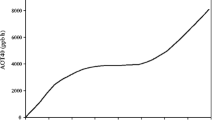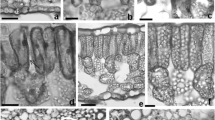Abstract
In this study, impacts of O3 on four cultivars (‘Rose’, ‘Pink’, ‘Blush’ and ‘White’) of the polka dot plant with variegated leaves were investigated for the first time. Ozone fumigation [(120 ± 20 ppb) for 14 days (8 h day−1, from 8:30 to 16:30)] resulted in visible foliar injuries, decreased contents of pigments (chlorophyll a and b, and carotenoid), the inhibition of photosynthesis, the increase of quantum yield of non-regulated heat dissipation and fluorescence emission (Y(NO)), and the damage of cell membrane. Elevated O3 increased the content of anthocyanin (Ant). ‘White’ showed the highest, and ‘Rose’ the lowest amount of injured leaf area, indicating that the former was the most sensitive, and the latter the most tolerant to O3 stress. After O3 exposure, the highest Ant content was found in ‘Rose’, followed by ‘Pink’, ‘Blush’, and ‘White’. Levels of Ant were likely responsible for the different sensitivities to O3 due to their roles in photoprotection.






Similar content being viewed by others
References
Aoki C, Wada T, Nishimura T, Hattori K (1995) Characterization and inheritance of ‘Variegated-leaf’ mutant in Petunia hybrida. Jpn J Breed 45:31–35
Avnery S, Mauzerall DL, Liu J, Horowitz LW (2011) Global crop yield reductions due to surface ozone exposure: 1. Year 2000 crop production losses and economic damage. Atmos Environ 45:2284–2296
Biswas DK, Xu H, Li YG, Liu MZ, Chen YH, Sun JZ, Jiang GM (2008) Assessing the genetic relatedness of higher ozone sensitivity of modern wheat to its wild and cultivated progenitors/relatives. J Exp Bot 59:951–963
Brandão SE, Bulbovas P, Lima MEL, Domingos M (2017) Biochemical leaf traits as indicators of tolerance potential in tree species from the Brazilian Atlantic Forest against oxidative environmental stressors. Sci Total Environ 575:406–417
Calatayud A, Iglesias DJ, Talón M, Barreno E (2003) Effects of 2-month ozone exposure in spinach leaves on photosynthesis, antioxidant systems and lipid peroxidation. Plant Physiol Biochem 41:839–845
Degl’Innocenti E, Guidi L, Soldatini GF (2007) Effects of elevated ozone on chlorophyll a fluorescence in symptomatic and asymptomatic leaves of two tomato genotypes. Biol Plant 51:313–321
Feild TS, Lee DW, Holbrook NM (2001) Why leaves turn red in autumn. the role of anthocyanins in senescing leaves of red-osier dogwood. Plant Physiol 127:566–574
Feng ZW, Jin MH, Zhang FZ, Huang YZ (2003) Effects of ground-level ozone (O3) pollution on the yields of rice and winter wheat in the Yangtze River Delta. J Environ Sci 15:360–362
Gould KS, Neill SO, Vogelmann TC (2002) A unified explanation for anthocyanins in leaves? Adv Bot Res 37:167–192
Hao Z, Chang J, Xu Z (2004) Plant physiology experiment. Harbin Inst Technol Press, Harbin, pp 106–108 (in Chinese)
He J, Qin L, Chong EL, Choong TW, Lee SK (2017) Plant growth and photosynthetic characteristics of Mesembryanthemum crystallinum grown aeroponically under different blue-and red-LEDs. Front Plant Sci 8:1–13
Heath RL (2008) Modification of the biochemical pathways of plants induced by ozone: what are the varied routes to change? Environ Pollut 155:453–463
Hughes NM, Smith WK (2007) Attenuation of incident light in Galax urceolata (Diapensiaceae): concerted influence of adaxial and abaxial anthocyanic layers on photoprotection. Am J Bot 94:784–790
Innes JL, Skelly JM, Schaub M (2001) Ozone and broadleaved species: a guide to the identification of ozone-induced foliar injury. Haupt, Bern, pp 42–43
Iriti M, Faoro F (2008) Oxidative stress, the paradigm of ozone toxicity in plants and animals. Water Air Soil Pollut 187:285–301
Ismail IM, Basahi JM, Hassan IA (2014) Gas exchange and chlorophyll fluorescence of pea (Pisum sativum L.) plants in response to ambient ozone at a rural site in Egypt. Sci Total Environ 497–498:585–593
Kim J, Kang SW, Pak CH, Kim MS (2012) Changes in leaf variegation and coloration of English ivy and polka dot plant under various indoor light intensities. HortTechnology 22:49–55
Maamar B, Maatoug M, Iriti M, Dellal A (2015) Physiological effects of ozone exposure on De Colgar and Rechaiga II tomato (Solanum lycopersicum L.) cultivars. Environ Sci Pollut Res 22:12124–12132
Paoletti E (2007) Ozone impacts on forests. CAB Rev 2:1–13
Paoletti E, Ferrara AM, Calatayud V, Cerveró J, Giannetti F, Sanz-Sanchez MJ, Manning WJ (2009) Deciduous shrubs for ozone bioindication: Hibiscus syriacus as an example. Environ Pollut 157:865–870
Paoletti E, Castagna A, Ederli L, Pasqualini S, Ranieri A, Manning WJ (2014) Gene expression in snapbeans exposed to ozone and protected by ethylenediurea. Environ Pollut 193:1–5
Pellegrini E, Francini A, Lorenzini G, Nali C (2011) PSII photochemistry and carboxylation efficiency in Liriodendron tulipifera under ozone exposure. Environ Exp Bot 70:217–226
Pellegrini E, Francini A, Lorenzini G, Nali C (2015) Ecophysiological and antioxidant traits of Salvia officinalis under ozone stress. Environ Sci Pollut Res 22:13083–13093
Picchi V, Monga R, Marzuoli R, Gerosa G, Faoro F (2017) The ozone-like syndrome in durum wheat (Triticum durum Desf.): mechanisms underlying the different symptomatic responses of two sensitive cultivars. Plant Physiol Biochem 112:261–269
Pleijel H, Eriksen AB, Danielsson H, Bondesson N, Selldén G (2006) Differential ozone sensitivity in an old and a modern Swedish wheat cultivar––grain yield and quality, leaf chlorophyll and stomatal conductance. Environ Exp Bot 56:63–71
Ruhland CT, Fogal MJ, Buyarski CR, Krna MA (2007) Solar ultraviolet-B radiation increases phenolic content and ferric reducing antioxidant power in. Avena sativa. Molecules 12:1220–1232
Saitanis CJ, Bari SM, Burkey KO, Stamatelopoulos D, Agathokleous E (2014) Screening of Bangladeshi winter wheat (Triticum aestivum L.) cultivars for sensitivity to ozone. Environ Sci Pollut Res 21:13560–13571
Sitch S, Cox PM, Collins WJ, Huntingford C (2007) Indirect radiative forcing of climate change through ozone effects on the land-carbon sink. Nature 448:791–794
Svenson SE, Johnston DL (1994) Photoselective shading compounds regulate growth of Hypoestes phyllostachya Bak. HortScience 29:737–737
Tiwari S, Grote R, Churkina G, Butler T (2016) Ozone damage, detoxification and the role of isoprenoids-new impetus for integrated models. Funct Plant Biol 43:324–336
Tong L, Zhang HL, Yu J, He MM, Xu NB, Zhang JJ, Qian FZ, Feng JY, Xiao H (2017) Characteristics of surface ozone and nitrogen oxides at urban, suburban and rural sites in Ningbo, China. Atmos Res 187:57–68
Vaultier MN, Jolivet Y (2015) Ozone sensing and early signaling in plants: an outline from the cloud. Environ Exp Bot 114:144–152
Wang X, Qu BH, Lu YX, Yang HX (2016) Cloning and expression analysis of anthocyanins synthesis related gene PyANS of apple pear peel. North Hortic 5:108–112 (in Chinese)
Xu H, Chen SB, Biswas DK, Li YG, Jiang GM (2009) Photosynthetic and yield responses of an old and a modern winter wheat cultivar to short-term ozone exposure. Photosynthetica 47:247–254
Zhang L, Xu H, Yang JC, Li WD, Jiang GM, Li YG (2010) Photosynthetic characteristics of diploid honeysuckle (Lonicera japonica Thunb.) and its autotetraploid cultivar subjected to elevated ozone exposure. Photosynthetica 46:87–95
Zhang L, Xiao S, Chen Y, Xu H, Li Y, Zhang Y, Luan F (2017) Ozone sensitivity of four Pakchoi cultivars with different leaf colors: physiological and biochemical mechanisms. Photosynthetica 55:478–490
Zheng YF, Zhang JE, Wu RJ, Zhao Z, Hu CD (2010) Effects of ozone stress on photosynthesis and physiological characteristics of winter wheat in northern China. J Agro-Environ Sci 29:1429–1436 (in Chinese)
Acknowledgements
We would like to thank two anonymous reviewers for their helpful and constructive comments.
Funding
This study was financially supported by National Natural Science Foundation of China (31401895) and ‘Young Talents’ project of Northeast Agricultural University of China (14Q10).
Author information
Authors and Affiliations
Corresponding author
Rights and permissions
About this article
Cite this article
Sui, J.X., Wen, M.X., Jia, L.L. et al. Effects of Elevated Ozone on Polka Dot Plant (Hypoestes phyllostachya) with Variegated Leaves. Bull Environ Contam Toxicol 99, 445–451 (2017). https://doi.org/10.1007/s00128-017-2163-x
Received:
Accepted:
Published:
Issue Date:
DOI: https://doi.org/10.1007/s00128-017-2163-x




